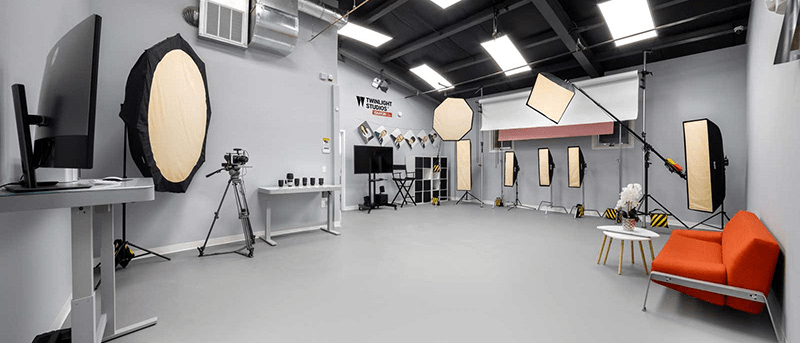Question: My friend has a pretty large basement in his house. We would like to make a small production studio. We already have two decent cameras and tripods. For editing and post production we have a Mac and FCPX. We want to do some chroma-keying, and some editing and publishing. What are some facts to consider before we move all of this equipment?
Answer: If you want to convert any room into an inexpensive TV studio, your most important step is to select a problem-free space. A basement is a great spot, but you have to think about temperature control, it may be under a heavily traveled kitchen or corridor requiring you to insulate against the sound of footsteps, air conditioner noises, the roar of a furnace, the whine of a pump, or even the deedle-deedle of a nearby telephone or alarm can be very expensive to seal out. In short, you need to pick a quiet place with plenty of electricity and no unusual noise, heating or moisture problems.
An enormous production space isn’t necessary unless you’re setting up a Ben Hur chariot race scene. You’d be surprised at how small most broadcast news and sitcom sets are. To the viewer, what is seen on the screen is all that matters; whatever is off screen by just a foot (i.e. garden tools, clothes racks, storage shelves stacked with paint cans) doesn’t exist.
A simple set, a wall mural, a bookshelf and a potted plant, or a chromakey blue curtain is all that is needed to suspend reality. Big studios aren’t necessary.
Some factors to consider:
 Controlling Sound
Controlling Sound
Some sounds can be controlled easily. Pumps, furnaces, air conditioners, and other motors can be turned off during the shoot and turned back on again afterwards. It is the “surprise” sounds of telephones, footsteps, barking dogs, and other people’s air conditioners that will be harder for you to control.
Basement walls are generally concrete and soundproof — outside the walls, nothing is as quiet as dirt. Your biggest sound infiltration will be from overhead or maybe from a nearby furnace, or crickets, or whatever else makes noise in your basement.
High ceilings
The trouble with basements is that they generally have low ceilings, making it hard to hang lights.
If this is the case, you might choose to bypass a lighting grid all together and just place your fixtures on temporary tripods like those sold in kits from Lowel Lighting (www.lowel.com), and Arri USA (www.arri.com).
Lighting
In the small studio, incandescent lights, even the professional tungsten halogen types, have three problems, they create a lot of heat, use a lot of electricity, and create harsh shadows. The small studio probably cannot handle a high electrical load, nor can its air conditioner rid the room of the heat. Because the lights are so close to the talent, the image tends to “bloom”, causing white skin and white objects to appear too bright when in the direct beam of the light.
Professional fluorescent lights like those from Lowel, Balcar (balcar.com), Kino-flo (kinoflo.com), and Videssence, although relatively expensive (about $1000 per fixture) may be an excellent long term solution. The fluorescent lights use about 15% the power, create about 15% the heat, and make soft, appealing shadows. Special fluorescent tubes provide an even 3200° K color temperature. The fixtures can be aimed and the lamps dimmed. Because the color temperature is 3200° K, the light can be mixed with other incandescent lights so that you get the best of both worlds. You could, for instance, use one 300W fluorescent fixture for key light, a second for fill light, and a sharply focused 600W halogen lamp for a back light.
Sound control
Unwanted sound comes from two places: outside the studio and inside the studio. Let’s deal with the outside first.
Sound will enter your studio if it can find holes in the wall, cracks around doors and windows, and spaces around pipes and duct work. Somehow you need to seal the room tightly so that air cannot get in or escape.
Weatherstrip all the doors and windows. If you are not using a window, you may wish to cover it with plywood and seal it that way. Caulk any loose fitting walls or wall-to-ceiling joints and any places where pipes and wires enter the room. If a hole is too large to caulk, try stuffing fiberglass insulation into it.
Sliding glass doors and steel doors designed for exterior use are often weatherstripped and seal nicely. The same goes for exterior thermopane windows.
The bigger the room, the fewer the echoes. If you have a choice of using a large room, half of which may simply be storage, then do it. All that extra air space of the storage room will work to your advantage.
If you can’t afford a big room, then at least make the room asymmetrical. A cubic room (one with a square floor and square walls) has the worst echoes. An oblong room would be better. Crooked walls and ceilings break up echoes by bouncing them in random patterns.
Next, cover the walls with sound absorbing materials. You could use fiberglass insulation held in place with chicken wire or you could carpet the walls, or even cover them with acoustical ceiling tiles. You could staple egg crates to the walls (remembering that flammable materials could create a fire hazard). Their non-flat surfaces chew up echoes like famished crocodiles. Carpet the floor and use acoustical tile in the ceiling. If your ceiling has bare joists, you don’t have to install a dropped ceiling; you could simply glue ceiling tiles to every flat surface that faced the floor — the joists themselves do a good job of breaking up echoes.
Covering the walls with heavy curtains will deaden echoes while providing a nice backdrop. If curtains seem too expensive, try finding a source of old, used curtains; nearly any heavy fabric will do.
Electrical:
You will want to provide a 90 amp (minimum) service panel for your project studio. Off of this service, you will want to run a minimum of four 20 amp circuits. Circuits should be run in metal conduit. Non metallic electrical cabling often doesn’t meet electrical codes and, more importantly, radiates a strong magnetic field that can be picked by audio equipment and wiring. An easy to use flexible conduit can be purchased that already has wires installed in the conduit; The greater expense of this type of cabling is well worth it.
The temporary studio
Perhaps you cannot afford to dedicate a room to your television business; you just need a studio once in a while. It’s possible to build a studio in an area that is used for other things, such as a workshop, a garage, office, or bedroom. Once you’ve figured out how to control the sound in the room and have found a way to hang lights in the right places, you can remove the lights and use the room for your other purpose until you need it as a studio. Find ways to make the room compatible between various uses.
Creating a mini TV studio in your home may seem like a lot of work. But remember, you do not necessarily have to do the job exactly right. Anything you do will be an improvement over shooting in the kitchen. Just a little wall treatment and sound insulation will go a long way to taking amateur-sounding echoes out of your standup presentations. Adjusting your lights just a little more perfectly will add dimension and color and professionalism to your shots. And finally, having a door between you and your family may give you the privacy and quiet you need in order to concentrate on this creative endeavor we call television production.






